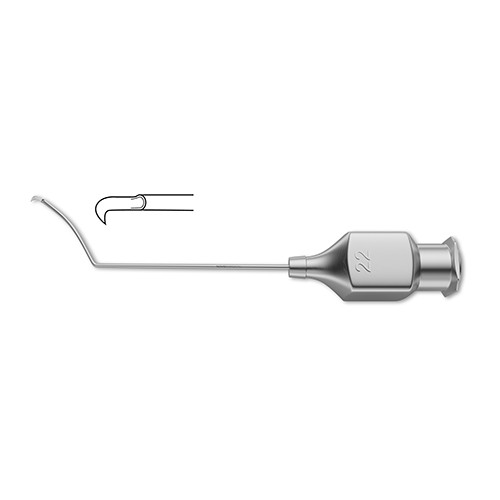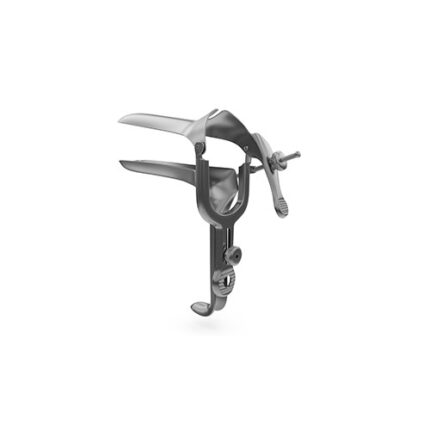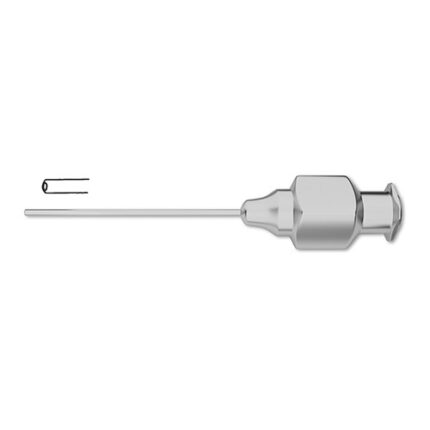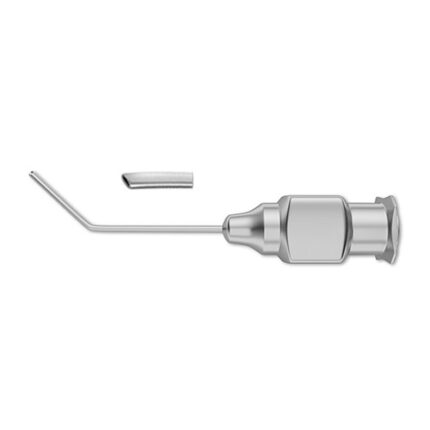| Name | Kratz Cystotome |
| Lead Time | Lead time advised within 48 hours of order placement. |
| Competitor | ;OP0900101;OP0900-101;601030;60-1030;6010-30; |
| Specialty | Ophthalmology-Cannulas |
| Material Finish | Stainless Steel |
| Grade | Premium Operating Room |
| Units of Measurement | Each |
| Manufacturer | JBS Industries |
| Sterility | Non-Sterile |
| Usage | Reusable |
Kratz Cystotome
30-gauge Kratz Cystotome is a commonly used tool during cataract phacoemulsification procedures. The cystotome may be used to create a circular incision in the anterior capsule before proceeding with aspiration of the lens. The sharp tip combined with 60 degree angled shaft allows for easy cutting and visualization.
SKU:
JBS-7312
Category: Cannulas
Description
Reviews (0)
Be the first to review “Kratz Cystotome” Cancel reply
Shipping & Delivery
Related products
Lacrimal Cannula
SKU:
JBS-4622
1.2" (3.1 cm) shaft w/ 2.0 cm reinforced, 23-gauge Lacrimal Cannula is an extremely useful tool in treating tear duct obstructions. The cannula may be used to investigate blockage of lacrimal gland damage or more frequently, obstruction of the nasolacrimal duct. The slender profile of the cannula allows access to the small entrances of the duct. Two different working lengths are available with the cannula depending on surgical preference.
Kratz Capsule Scraper
SKU:
JBS-2287
shaft w/ sharp top, shaft angled 60 degrees, 12.0 mm tip from angle to tip, 22-gauge, 1/2" Kratz Capusle Scraper is a useful tool in phacoemulsification procedures. The sandblasted tip is designed to scrape the surface of the posterior capsule to remove and cellular debris following aspiration of the nucleus.
McIntyre Anterior Chamber Cannula
SKU:
JBS-9562
McIntyre Anterior Chamber Cannula is a frequently used tool in cataract IOL implantation procedures. Following nucleus fragmentation, the cannula may be used to aspirate any remaining debris from the anterior chamber. Both angled and straight tips are available in three different gauges depending on surgical preference.
Bracken Anterior Chamber Cannula
SKU:
JBS-6225
curved, 19-gauge, overall length excluding hub 13/16" (2.1 cm) Bracken Anterior Chamber Cannula is a frequently used tool in cataract extraction procedures. The small gauge cannula is nimble enough to fit into a small limbal incision accessing the anterior chamber. It may be used to aspirate fluid within the anterior chamber exposing the lens capsule. The curved nature of the shaft assures minimal surgical obstruction.
Knolle-Pearce Irrigating Lens Loop
SKU:
JBS-8171
1.0 mm tip, angled 30 degrees, sandblasted, 23-gauge, 3/4" (2.0 cm)Knolle-Pearce Irrigating Lens Loop is a useful tool for cataract and lens extraction procedures. The loop is instated between the nucleus and the posterior capsule; fluid is allowed to pass into this space to allow for easier removal of the lens. Three irrigation ports provide ample fluid distribution.
McIntyre-Binkhorst Irrigating Cannula
SKU:
JBS-5397
smooth blunt tip, front opening, 26-gauge McIntyre-Binkhorst Irrigating Cannula is a useful tool in cataract procedures. The curved tip of the cannula is used for loosing the peripheral cortex of the lens during difficult extraction. The cannula features a smaller gauge for easier access and a shorter working length for more control. Both right and left curvatures of the cannula are also available depending on surgical preference.
Nucleus Hydrodissection Cannula
SKU:
JBS-1234
25 gauge, 7.0 mm angled shaft w/ flattened tip, overall length 21.0 mm (excluding hub)Nucleus Hydrodissection Cannula is a useful tool in cataract extraction procedures. The cannula can be used to manipulate and rotate the lens during a hydrodissection for easier extraction. The small gauge with flattened tip assures minimal trauma to the surrounding tissue.
Gills-Welsh Cannula
SKU:
JBS-7226
25-gauge, angled Gills-Welsh Cannula is a commonly used tool in cataract and various other ophthalmologic procedures. The small gauge of the cannula may be used to aspirate fluid in the anterior chamber of the eye following a limbal incision. Four different angles are available with the cannula depending on surgical preference.













Reviews
There are no reviews yet.